How not to lose the chance. The comprehensive recovery program is a road map of the priority steps for the recovery of Ukraine

How to avoid mistakes in post-war recovery? What and when to start the recovery processes? Whom and how to involve? Dr. sc. ETH/SIA Haris Piplas - Co-Directing Urban Design, Planning and Development in Integrated Urban Solutions Drees & Sommer and Lidiia Chyzhevska – urban planner at Integrated Urban Solutions, explain in detail how municipalities can develop and use the new tool named "The Comprehensive Recovery Program of the Region and Territory territorial community" - for a holistic approach to reconstruction planning.
Prerequisites for Ukraine´s recovery
Exactly a year has passed since the beginning of a full-scale war. In the first months after the initial shock of the onset of these terrible events had gone, Ukrainian architects, urban planners, and our international colleagues began to collaborate and develop approaches and concepts for the Ukraine recovery.
During this time, the Ukrainian government proposed a new planning instrument named the Comprehensive Recovery Program for the oblast (region) and the territory of the territorial Hromada (municipality) (its parts), aiming to ensure the need for rapid recovery and adapting to the complexity of the situation.
Image 1. Legal Framework for Ukraine recovery - comprehensive Recovery Programs
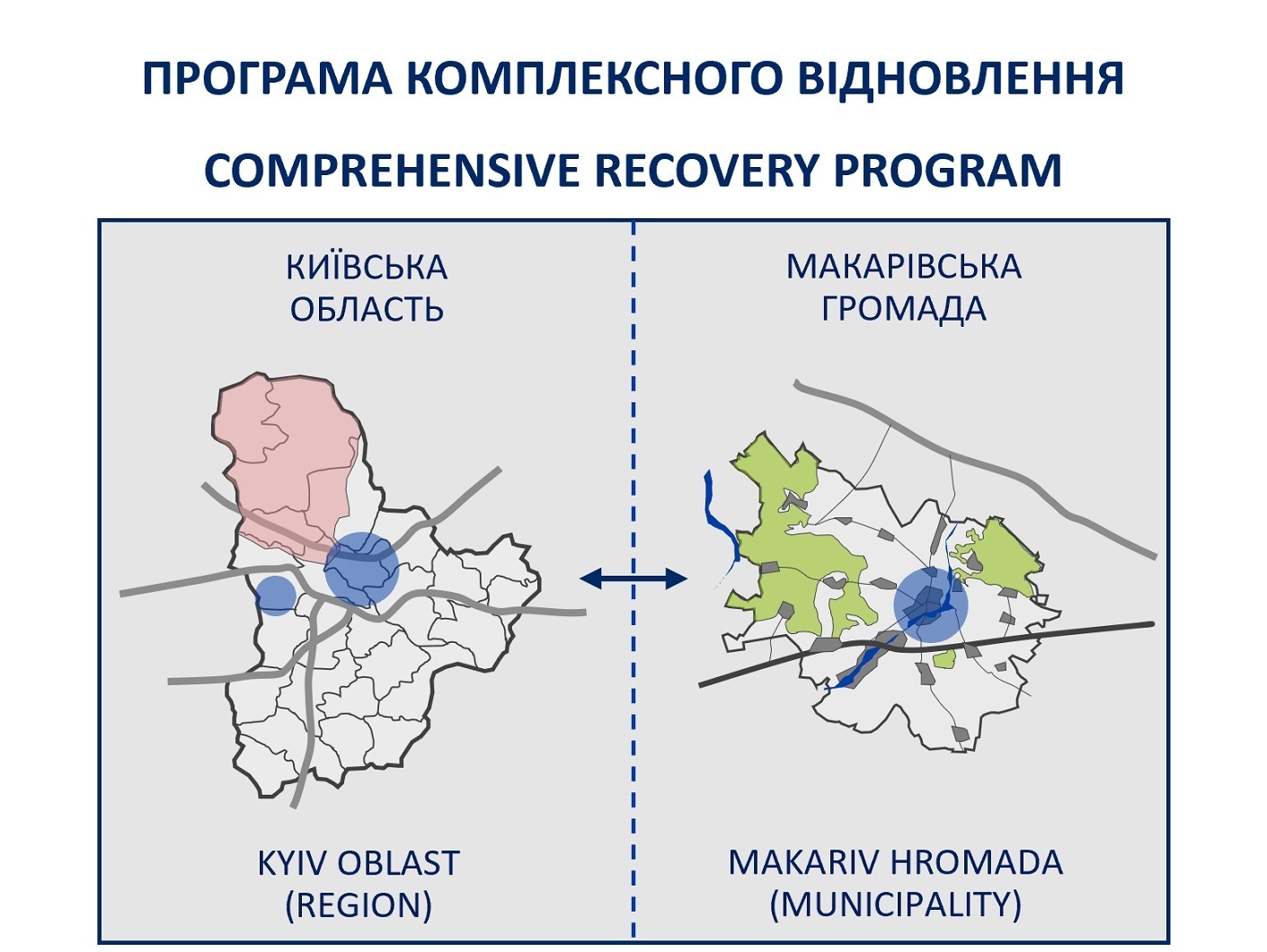
The study of global cases of post-war reconstruction, the solidarity of international organisations, and numerous discussions and conferences this year did not give a clear understanding for all participants: Is it reasonable to think about reconstruction and development plans before the war's end? Some cities, like Kharkiv, Mykolaiv, and Hromadas (municipalities) like Makariv, Irpin, Gostomel, Rohan, have already started their path toward recovery processes. But the main question remains how to achieve of sustainable, comprehensive recovery that winners deserve?
When and how should the process of recovery of the territory start?
The rescue should start immediately rather than waiting for the “perfect moment” that will never come. In particular, the preparatory work is not to be underestimated: a large number of activities are aimed at defining the framework and concept, such as limiting the vision, setting up a local team, developing a communication strategy, and determining the participation of all interested stakeholders, including the public – before the implementation begins.
In order to have a holistic overview of the status quo and the architectural but also socio-economic damages and losses, it is necessary to do a broad analysis and diagnostics that include data collection on all available resources. Field and satellite research, review of the legislative basis, interview, etc.
What are the main faults that can be avoided when recovering territories?
Approach the process comprehensively.
Precise coordination of actions and management of operations, determination of goals based on a systematic sectoral analysis of resources and the occurrents that have taken place, and prioritisation of goals and activities. It is important to approach such a complex multi-component process as territory recovery in a comprehensive manner. As a result, it gives a complete understanding, saves time, effort, and finances, and avoids duplication of similar or identical work.
Image 2. Approach and steps of developing the Comprehensive recovery program
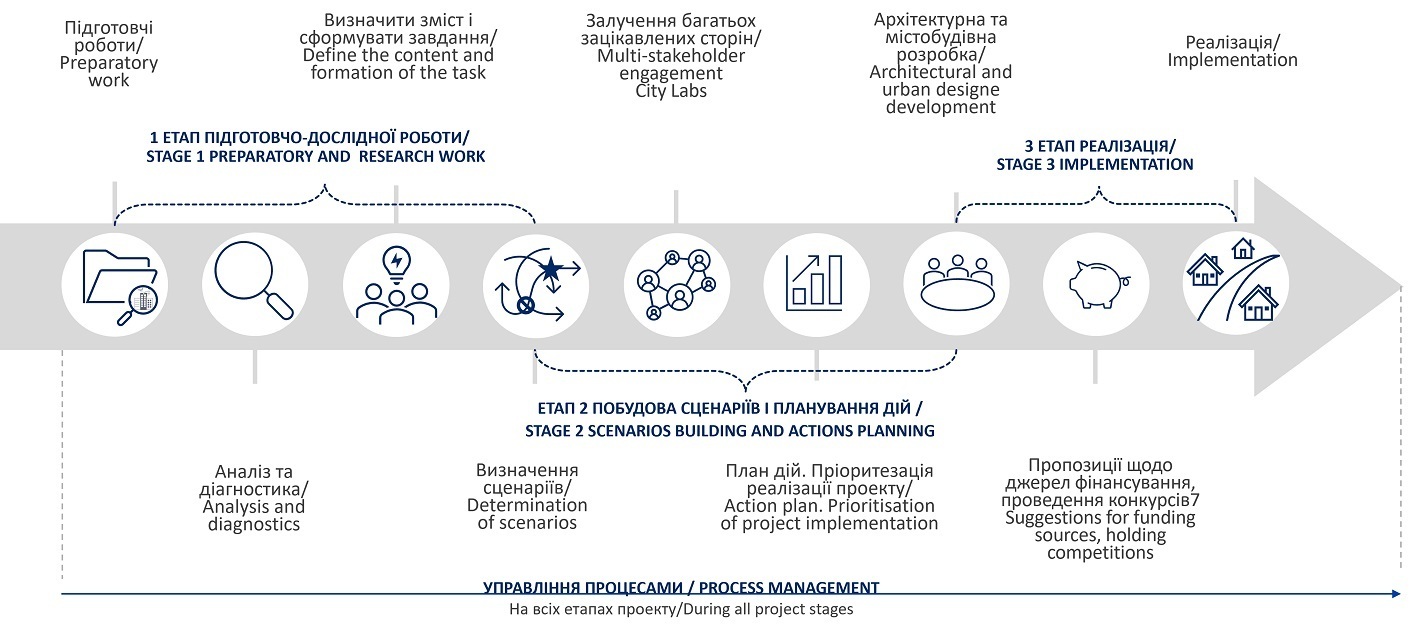
Using this approach, the process of developing an urban recovery program can be divided into three stages:
I The first stage is preparatory and research work. It includes setting up a local team and creating a communication strategy, determining the participation of all interested parties and the public, the process launch, data collection and analysis.
All possible focus work areas of actual overall intervention are defined based on integrated syntheses of overlapping different thematic layers of collected data (such as social infrastructure, commercial and economy, critical infrastructure, etc.). Without this is impossible to determine and formulate the specific goals and tasks of holistic recovery and sustainable territorial development. To speak in simple language, the process looks like this: First, collect all the data the more, the more complete the picture. Then, overlap them by putting them on the map, and you will notice all aspects and get a more overall picture.
As a result, the municipality, city will get a general and specific understanding of what had happened on their territory. What potentials exist, and what risks are still possible to prevent.
II We cannot determine when the war will end. However, we can anticipate possible scenarios and quickly adapt to changes. Therefore, the second stage is to build scenarios and plan actions that provide a possible vision of future options and help choose strategic tasks and action plans for their implementation.
During the development of such complex tasks, it is important to involve the public to the maximum extent possible, hold public discussions, and develop a truly integrated vision of a shared future.
Image 3. Drees & Sommer Integrated urban solution processes
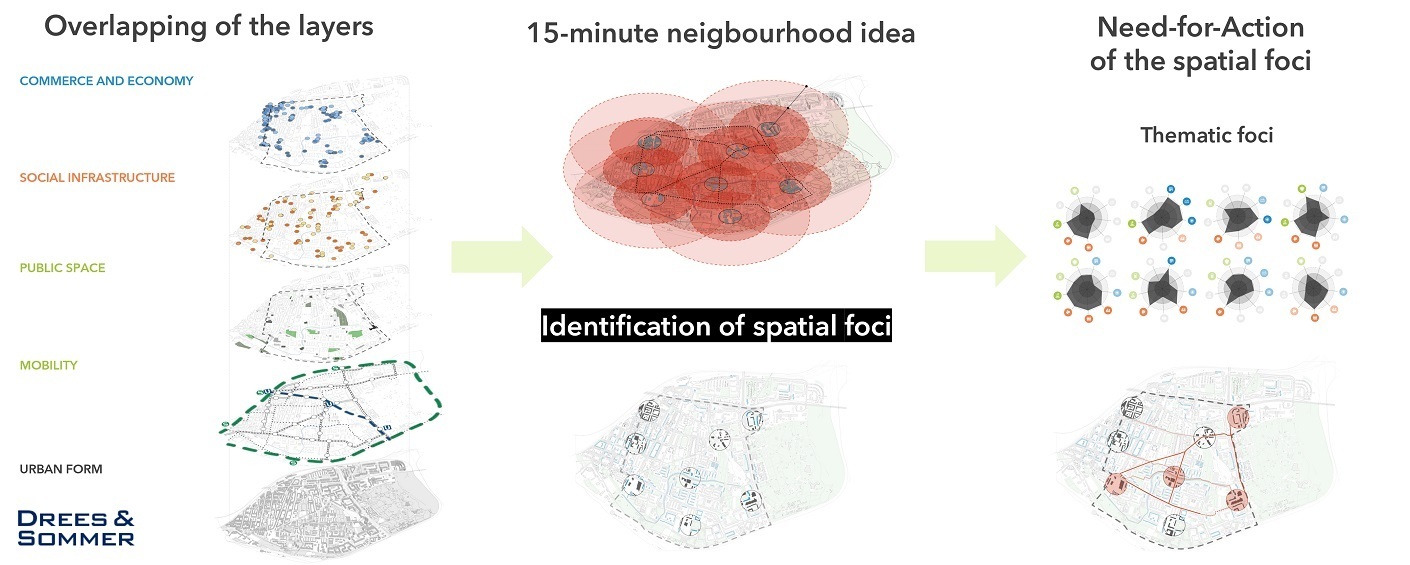
One of the weightiest steps and, at the same time, challenges is the involvement of different types of public. Multi-stakeholder engagement in scenario development and testing aimed to improve communication and build a connection between local government and the public sector. Municipalities must be able to make participatory decisions about their future. Their ability to implement these decisions, find resources and partners, and ultimately succeed depends on the quality of their decision-making processes.
Using such engagement instruments as city urban labs, workshops, seminars, and engagement events also aimed to avoid a point-by-point approach to recovery that leads only to the benefit of the private companies.
The implementation stage is aimed at a detailed description of ways to implement planning actions. It begins with considering the financial levers of achieving the result and ends with implementing a plan of measures.
The following important issue is the prioritisation of project implementation, with technical and economic rationale. Implementation (target goal) is based on developing an action plan with a detailed description of the required resources and funding.
An essential step of the implementation stage is holding architectural competitions to choose the best qualitative offer and a transparent way of finding the most qualified team to work on a project. These competitions must not be competitive in a traditional sense but also allow for collaboration between the design & planning teams but also the wider range of stakeholders: public, businesses, academia, international experts, public authorities etc. These “competition makeathons” could take place in City Action labs and allow for a co-creative effort in the recovery process with less friction and more ownership between the different interest groups.
The project management mechanisms are fundamental at every recovery project stage. In general, only a quality and holistic approach to determining the financial, governance, coordination, and consultation mechanisms of an implementation work plan and reporting system, including monitoring and assessing the achievement of territory development indicators, leads to successful recovery.
Should local authorities wait for Ukraine's Recovery Plan, like a general recovery vision from the state?
The current tendency shows that many local and international respectable organisations have already started to move recovery processes. But this contribution needs to be more cohesive, curated and coordinated.
The majority of local authorities sitting with the main question, is it time to plan your future now? And waiting for the decision from national authorities and specific recipes regarding where to start and what to do.
Image 4. Comprehensive recovery program Makariv hromada (municipality)
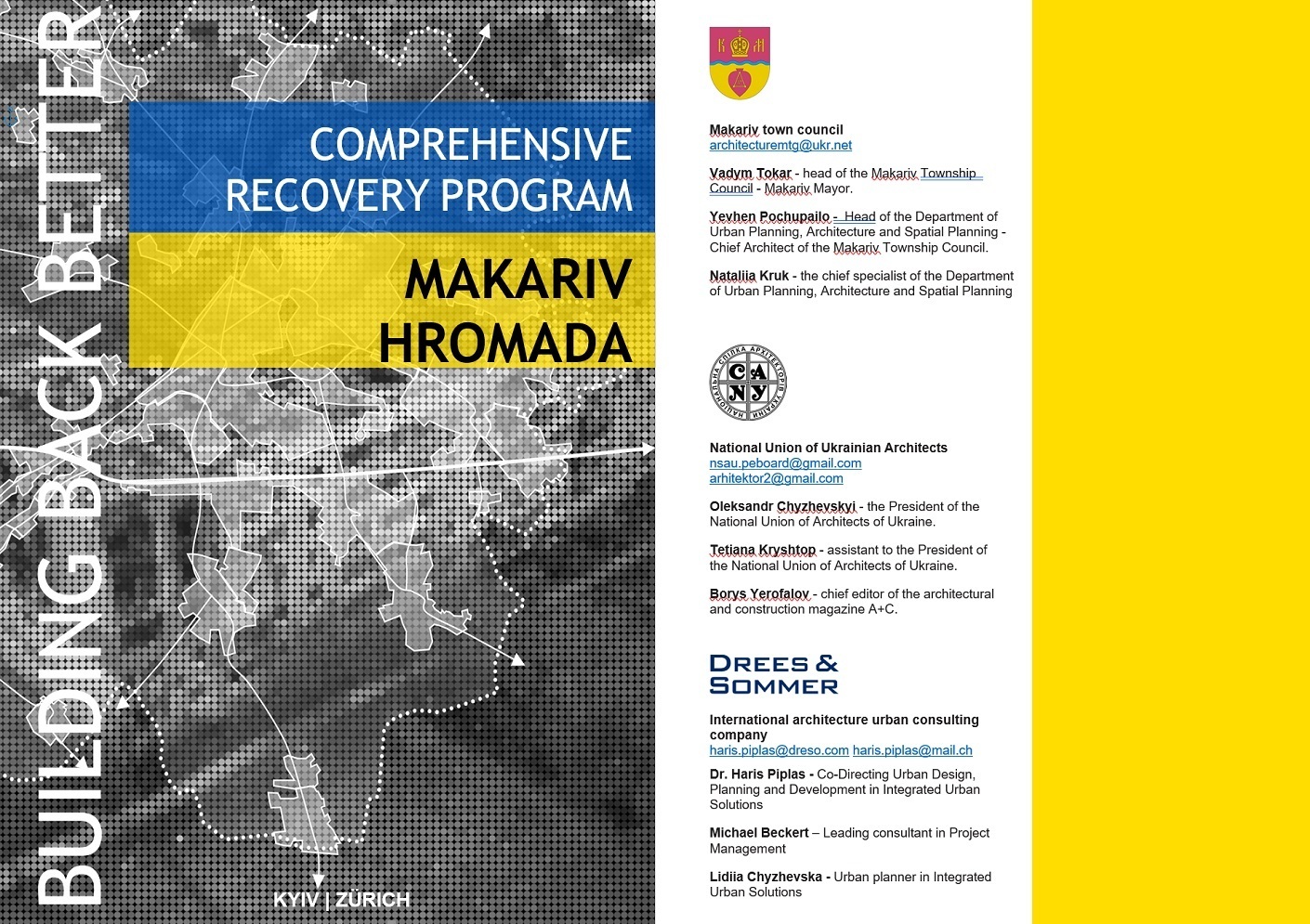
Despite the uncertainty and risks of a protracted conflict, some municipalities, such as Makariv, in cooperation with the international architecture, planning and consulting company Drees & Sommer – Integrated Urban Solutions and the Union of Architects of Ukraine and the Architectural Chamber of NSAU, are already taking active measures to recover the life of the Municipality and revive the economy and development of the territory.
After the large-scale Russian invasion of Ukraine on February 24, 2022, Makariv and the Makariv Hromada (Municipality) villages became the centre of hostilities and bloodshed. Makariv and the towns of the Makariv Hromada (Municipality) lived under Russian occupation for a month and a half. The occupiers killed more than 200 civilians.
As a result of massive daily shelling by the Russians, 3,332 social, residential, and critical infrastructure objects were destroyed and damaged. The accessibility of the population to communal services, infrastructure, and the labour market has worsened.
Image 5. Comprehensive analysis of what had happened in Makariv hromada (municipality)

But Municipality acts now. In particular, they have prepared proposals for finding funding for the development of a recovery program. It is not enough to repair windows in a school when you do not understand how to restore heating and return residents back.
Restoration of destroyed objects or the construction of new ones?
By testing the approach and methodology of the pilot project of the Makariv municipality, we separate the problems of the issues posed to the local self-government bodies caused by the War into two groups. The first group issues that need an immediate and emergency solution. Restoration of electricity supply, water supply, and life support systems for the population, such as installing broken windows in the school. The primary and most complicated question that municipalities should answer is whether there is a need to recover destroyed objects. How to get back the population? Do we need to rebuild all destroyed objects, or maybe some villages will never recover? For sure, it is a difficult question for the inhabitants of these villages. But this question was even before the War. Every year 19 villages are diapered in Ukraine due to urbanisation and population migration. Today after the War, this indicator can increase significantly.
The issue of legal regulation and the further fate of objects, such as houses, in such settlements remains open due to the complex mechanisms prescribed in the legislation. One thing remains clear, without precise planning based on an in-depth analysis of the situation, it is impossible to make balanced and rational decisions.
The second group of issues is a question of a strategic nature when the object has been destroyed and is subject to long-term capital restoration. In this case, assessing the situation and forming the basis for restoring such an object is advisable. In these cases, it is advisable to implement pilot projects for testing new approaches to the restoration of the territory. There are quite a lot of innovative technologies in the world that do not reduce, but on the contrary, they even increase comfort and quality of life, while building a house can be quick, simple, and made of recycled materials.
Image 6. EPEA Drees & Sommer Cradle to cradle – circular building principals
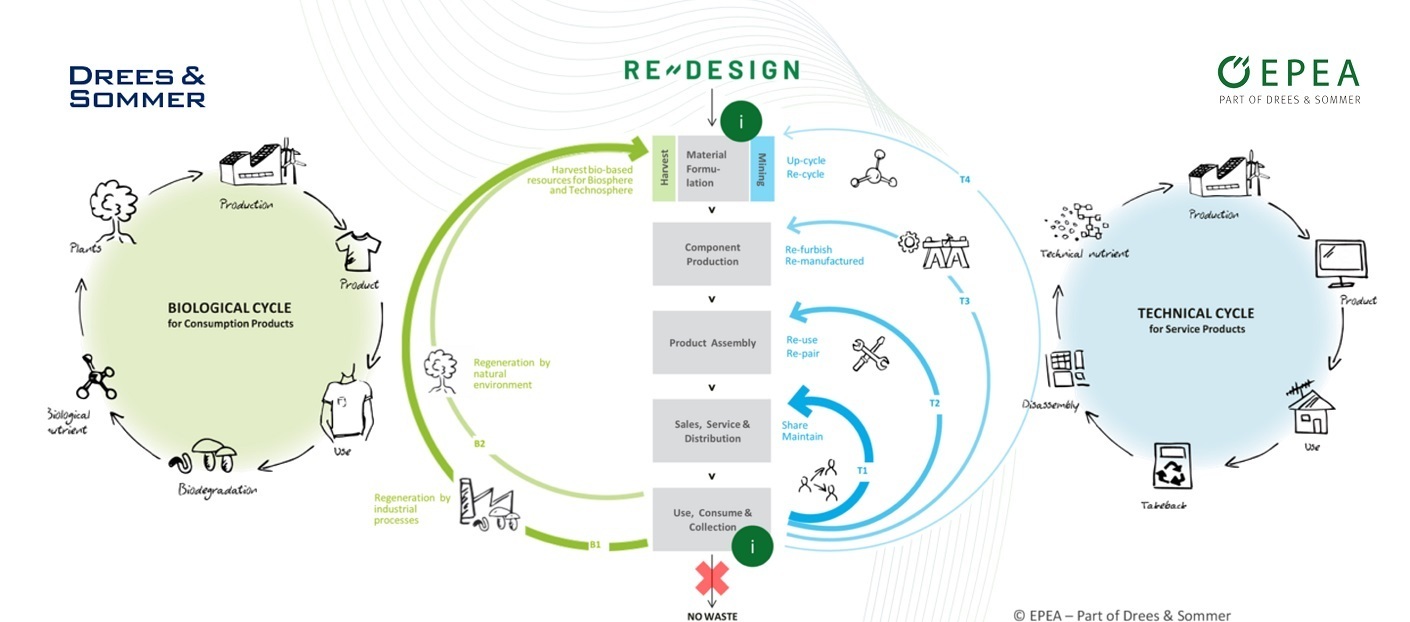
Since 2019, Drees & Sommer and the former EPEA Internationale Umweltforschung GmbH have been working together – with the aim of establishing the Cradle to Cradle design principles for the Circular Economy in all industries. EPEA's materials expertise forms the basis for optimising products from the molecular to the modular level.
This approach is attractive not only from an ecological point of view but also from an economic point of view, which is extremely necessary for reconstructing and increasing the sustainability of Ukrainian cities and municipalities.
Does the time of document development affect the quality of recovery planning? How to do it quickly and efficiently?
The urban recovery program should be a dynamic document. It shows and predicts actions at the time of creation moment. The settlement period of the action plan can consist of three stages. The first stage of 2-3 years is recovery and implementing rapid response emergency measures. The second stage consists of implementing recovery measures for the territory for an average of 5-7 years. The third stage of 10+ years is aimed at implementing the development measures. Such gradual and purposeful actions allow one to adapt to changes and evaluate progress and the appropriateness of decisions made.
Image 7. ALHO versatility of modular building methods
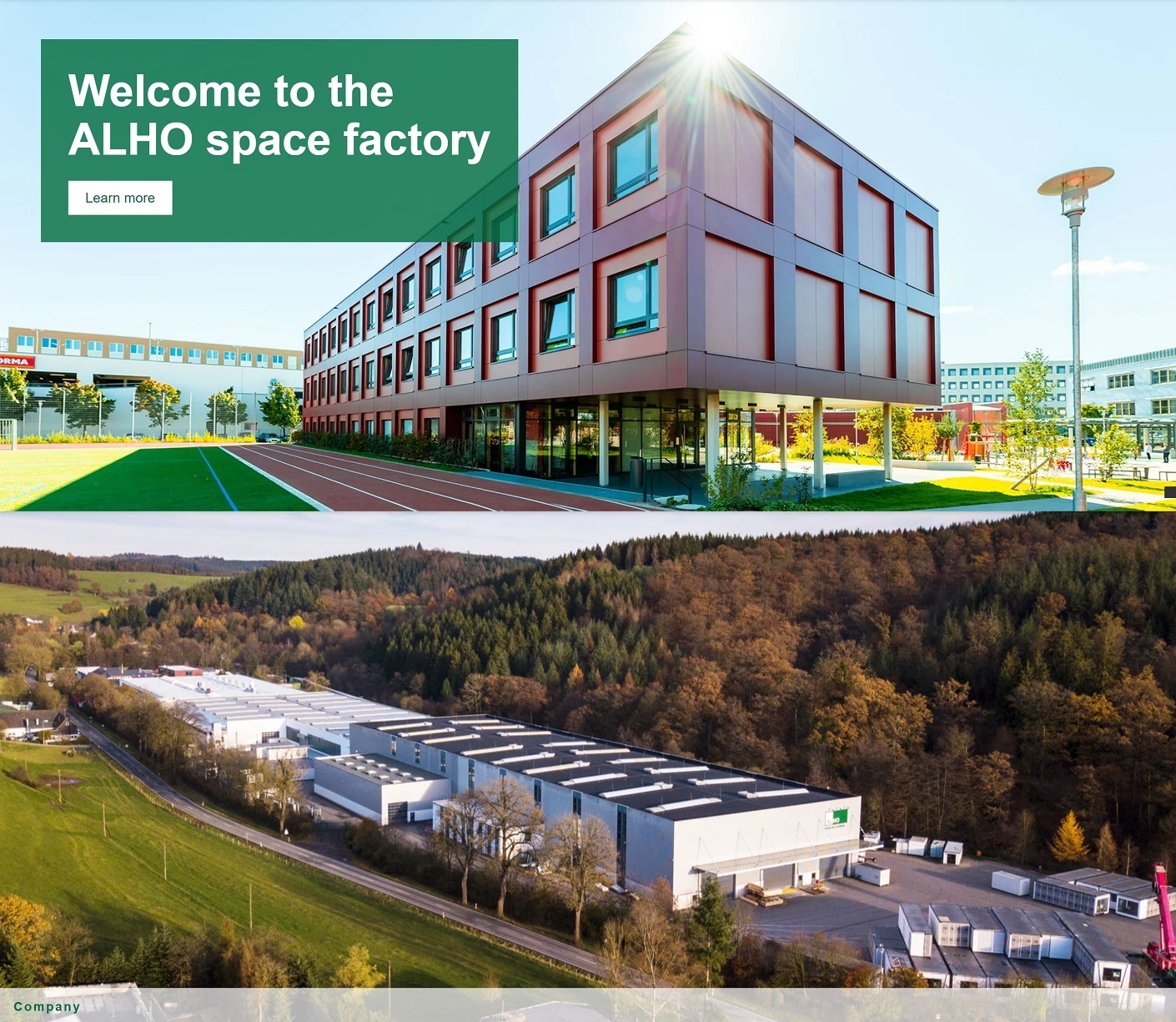
The implementation of the action plan is decisive in the process of sustainable recovery. Long does not always mean high quality, especially when we are talking about significant destruction of the housing stock. The house should have been built by yesterday. And the first thing that comes to mind when we put fast and housing in the same sentence is modular containers. Such a combination of words immediately prepares for aggression both from the side of fellow architects and from the side of the population, which often does not believe in the temporary nature of such housing. But successful European practices show otherwise.
For example, ALHO is a market leader in modular construction and implements the best procedures in modular building construction. With 50 years of experience in implementing this technology and continuous improvement, the company creates an individual approach to each type of building for fast and sustainable economic construction. ALHO pays special attention to the use and life cycle of materials. An Important Factor When Building Life cycle costs and what you should consider the term “life cycle costs,” or LCC abbreviated, refers to the sum of all expenses which are generated by a product over its entire life cycle, i.e., the service life of the product. Buildings which have been designed and implemented for the aspects of ecology and sustainability frequently prove to be the most economical variant, even considering more significant construction costs.
Such an approach clearly shows that even rapid construction from modules with correct calculations and applying more environmentally friendly innovative methods will provide economic benefits and a better quality of life in the future.ii
When can a city's recovery be considered successful? What are the criteria for recovery?
The success of reconstruction depends on improving and creating a new quality of life, increasing the capacity of local authorities, establishing connections, and providing a unique quality of services. The main priorities, the achievement of which is a criterion for the success of reconstruction, were formed by international and Ukrainian experts (Anna Bondar Ukrainian National Parliament, Kees Christiaanse KCAP, Lidiia Chyzhevska the National Union of Architects of Ukraine, Gyler Mydyti KCAP, Petr Navrat ONplan Lab, Otar Nemsadze GIZ Georgia & Tbilisi Architecture Biennale, Haris Piplas Drees&Sommer, Robert Youssef ONplan Lab) during the conference in Prague.
Image 8. Conference on Architecture and Building. Culture Policies – ECAP 2022 11-12.10.2022
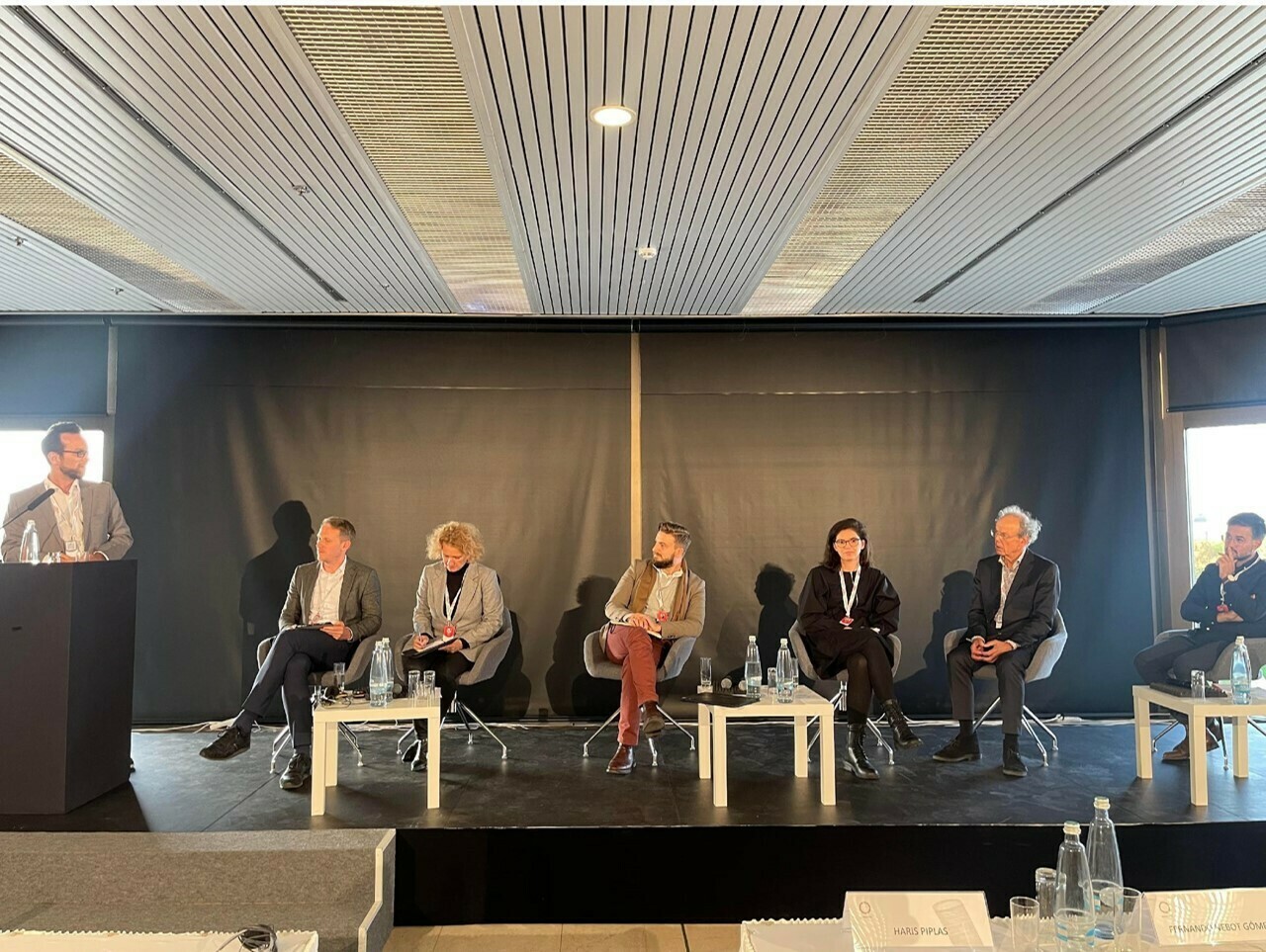
It is essential to combine local, state and international efforts by creating a legislative framework and policy to coordinate actions, including all possible stakeholders. Of course, the centre of reconstruction should be the municipality's needs. People-centeredness and creating a favourable environment for life are one of the main goals of recovery. Everything we do aims to improve the quality of everyday life.
Architecture and urban and strategic planning are the primary tools for achieving the sustainability and capacity of cities and adaptation to the consequences of tragic events. The traditional sectoral approach to planning in Ukraine should change to an integrated one, which, in turn, makes it possible to work and plan from two perspectives and dimensions.
Funds for reconstruction and restoration are pretty limited. It is unlikely to be possible to mobilise the entire amount at once. Therefore, it is crucial to understand and prioritise measures. For example, we all understand that providing affordable housing is a significant challenge. In turn, simple and quick solutions like the construction of containers can lead to complications in life conditions from a more global perspective.
In conclusion, the 10 commandments give a new quality and outline the framework conditions. What can help achieve comprehensive, step-by-step, socio-economically just and rethought reconstruction for every city and municipality in Ukraine. The crystallisation of this can be an idea of forces coordination under some umbrella organisations like the German IBA.
Image 9. Ten recommendations for Post-War urban renewal
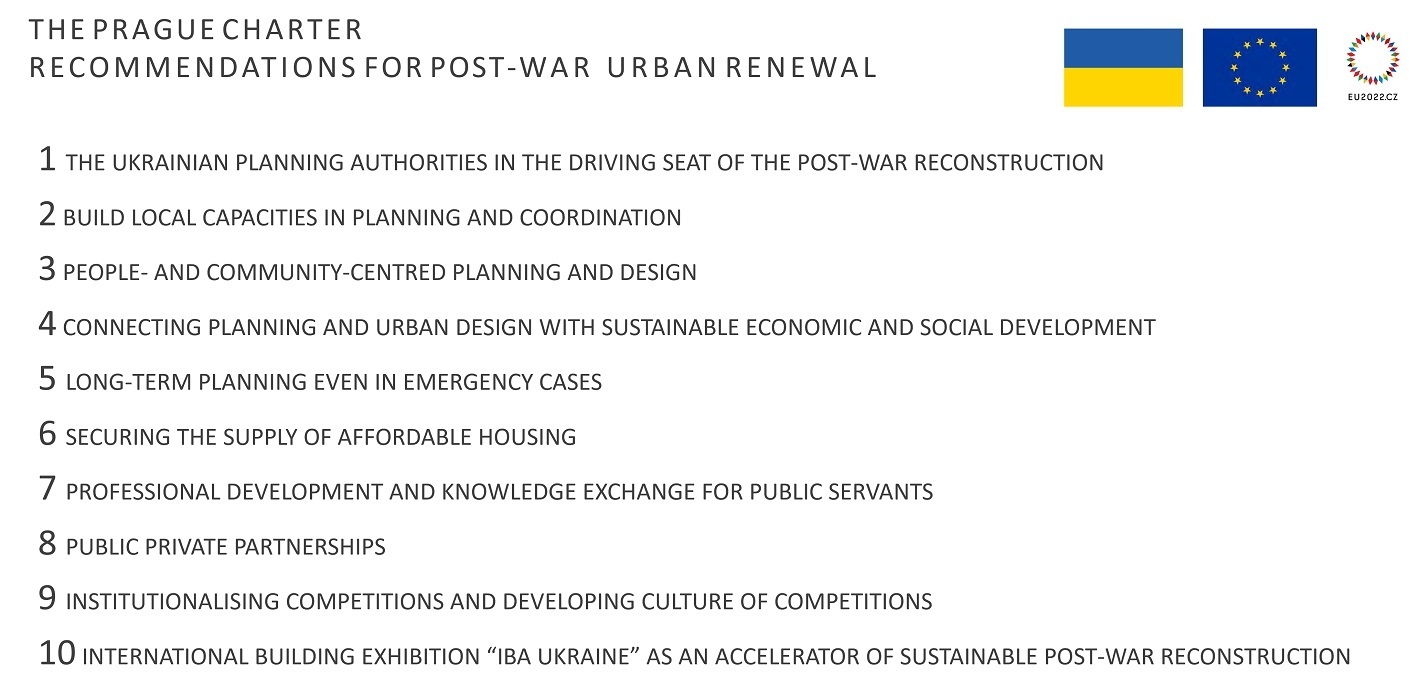
SUMMARY
We need to start the recovery planning process now. Planning recovery with the "as it was" principle is a road to nowhere—only a comprehensive analysis and rethinking of the existing can offer a building back better quality. The comprehensive recovery program is a document that allows you to gather a holistic picture and plan further steps and stages of recovery. Since the document is complex and covers all spheres of life, it is worth involving professionals and different groups of stakeholders in its development. In close cooperation with Ukrainian and international colleagues, achieving truly progressive, innovative and sustainable solutions is possible.
22 November 2024
Уряд затвердив розподіл додаткової дотації для місцевих бюджетів на майже 800 млн грн
Уряд затвердив розподіл додаткової дотації для...
22 листопада, Уряд затвердив черговий розподіл додаткової дотації для місцевих бюджетів, повідомили у Міністертсві...
22 November 2024
Окремі питання обмеження доступу до публічної інформації в ОМС в умовах воєнного стану
Окремі питання обмеження доступу до публічної...
Програма USAID DOBRE підготувала відеороз’яснення на тему: «Окремі питання обмеження доступу до публічної інформації...
22 November 2024
Конкурс «Громада на всі 100»: став відомий список фіналістів
Конкурс «Громада на всі 100»: став відомий...
Завершився другий етап конкурсу «Громада на всі 100», під час якого серед 261 громади обрали 40 учасників, що...
22 November 2024
Division of competences between the state and...
18 листопада у Бучі відбувся круглий стіл щодо розподілу повноважень органів місцевого самоврядування та органів...